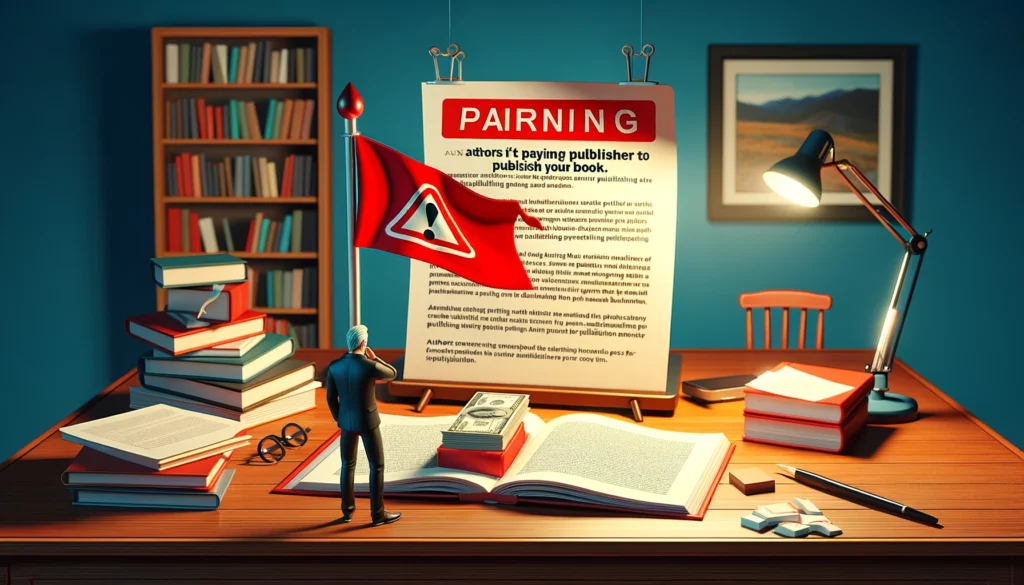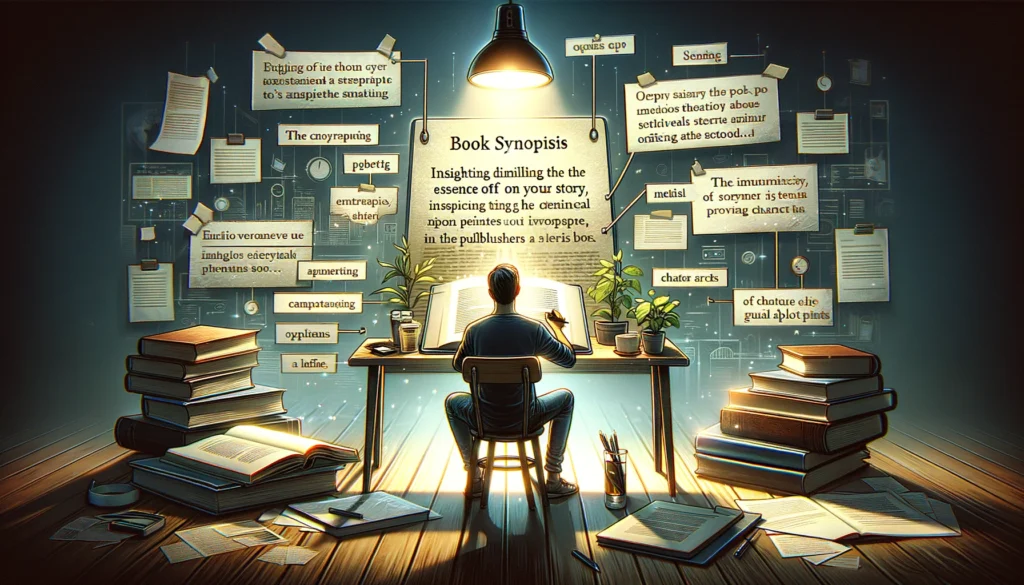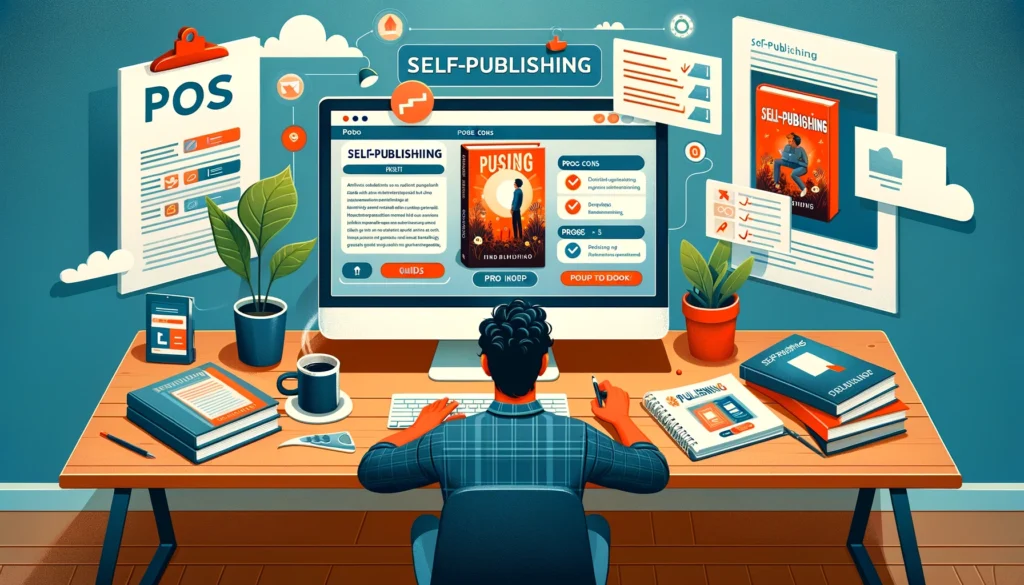Bringing your book to life can be a daunting process. Writing alone is time consuming, nerve wrecking, and often unfruitful. Then, it comes the publishing part. Which doesn’t really have to be a pain in the….
In this guide, I’ll try to give you some ideas how you can publish a book with a publisher, much easier and faster than you imagined.
Step 1: Finalize Your Manuscript

Alright, picture this: you’ve poured everything into your manuscript, and it’s nearly ready to see the world. But before we send it off, let’s give it the VIP treatment to make sure it’s absolutely glowing. Finalizing your manuscript is a bit like prepping for a big reveal. You want it to turn heads and capture hearts, right?
Self-Edit Your Manuscript
First things first, let’s talk self-editing. Imagine this as your manuscript’s personal glow-up. You’re on the lookout for any rough patches, plot holes that need filling, or characters that need a bit more shine. It’s about reading through your work with a critical eye but also lovingly polishing it. And hey, don’t be afraid to cut what doesn’t work. It’s all in the service of making your story pop.
Use Beta Readers
Now, it’s time to bring in the secret weapon: beta readers. These are the folks who give it to you straight before you step out into the spotlight. Pass your manuscript to trusted friends who love to read, or maybe even find a writing group online. They can offer priceless insights from a reader’s perspective, spotting things you might have missed because you’re just too close to it.
Hire a Professional Editor
After you’ve tweaked your manuscript with feedback, consider getting a professional editor. Yes, it’s a bit like hiring a personal trainer for your book. They’re there to help you tighten up those loose ends and make sure everything is in top-notch shape. A professional edit can elevate your manuscript from good to great, ensuring it’s in the best possible condition before you submit.
Embrace the Revision Process
This whole finalizing phase is really about embracing the journey from a rough draft to a polished gem. It’s not about making it perfect on the first go but being open to the process of improvement. Remember, all your favorite books went through this kind of transformation too.
So, take your time, shower your manuscript with attention, and soon you’ll be ready for the next big step: researching the market. It’s about finding the right stage for your manuscript to shine. Let’s make sure we’re heading to the right party, where your book can truly make a splash.
Use Ai tools to speed up the work
There are AI tools that can speed some work for you. From proofreading to revision and to even ideation.
So, when you prompt these properly, I don’t believe there’s much work needed to be done in terms of proofreading and editing manuscript.
For example, if you use Ai eBook creator, it’s likely you won’t need to proofread anything. There are no spelling mistakes, no grammar issues. In terms of a style and adding your own touch – maybe. Maybe you’d want to double check it, but you get the idea.
It’s better to focus just on style then on everything at the same time – style, proofreading, editing, etc.
Step 2: Research the Market

Imagine we’re on a treasure hunt, but instead of gold, we’re after the perfect spot where your book fits like a glove. Researching the market isn’t just smart; it’s essential. It’s about knowing the playground where your book can swing the highest.
Identify Your Genre and Target Audience
First things first: who’s going to love your book? Pinning down your genre and target audience is like knowing exactly what party you’re heading to. For genre specifics, Goodreads is a treasure trove. Browse through similar titles and see where your book could nestle in. Want to get a feel for your audience? Dive into forums like Reddit’s r/books or specific genre subreddits. You’ll get unfiltered opinions and maybe even discover a gap in the market your book can fill.
Find the Right Publishers and Agents
Now, for the matchmaking part. Agents and publishers are your book’s potential BFFs, but you’ve got to find the right match. For literary agents, check out AgentQuery or the Directory of Literary Agents on PublishersMarketplace. Both are gold mines for finding agents who are looking for manuscripts just like yours.
For publishers, especially if you’re eyeing smaller, independent houses that might be more receptive to debut authors, Poets & Writers Magazine and the Independent Book Publishers Association are fantastic places to start. They list publishers by genre, making your search a breeze.
Study Submission Guidelines
This part is crucial. Think of submission guidelines as the secret code to unlocking the treasure chest. Almost every agent or publisher’s website will have a submissions or FAQ section detailing what they want to see in your submission package. Follow these to the letter—it’s one of the simplest yet most overlooked steps to getting your foot in the door.
Keep an Eye on Market Trends
Staying ahead of the curve or even riding it can give your book an edge. Resources like Publishers Weekly or The Bookseller offer insights into what’s hot and what’s next. But remember, trends come and go; authenticity never fades.
Network with Other Writers
Never underestimate the power of community. Writers’ groups on Facebook or platforms like Scribophile offer not just support and advice but also networking opportunities that could lead to introductions with agents or publishers.
Researching the market is about positioning your book where it will thrive. It’s a mix of understanding where it belongs and finding the right partners to help it grow. Onwards to crafting that query letter that opens doors!
Step 3: Write a Query Letter

Alright, imagine your query letter is your book’s passport, its ticket to the world. Crafting a query that stands out is an art, but it’s an art you can master with a bit of guidance.
Understand the Anatomy of a Query Letter
Your query letter should have a gripping hook, a snappy book summary, a brief author bio, and a professional closing. For a deep dive into what makes a killer query, check out examples and tips on Writer’s Digest. They break down the anatomy of successful queries in a way that’s both informative and easy to digest.
Personalize Your Query
Your query needs to show that you’ve done your homework. Mention why you’re approaching this particular agent or publisher, maybe something they’ve represented or published before that aligns with your work. QueryTracker not only helps you track your submissions but also offers insights into agents’ profiles and preferences.
Keep It Professional and Concise
Brevity is the soul of wit, especially in query letters. Aim for no more than one page. For formatting and keeping it professional, look to resources like the Reedsy Blog for guidelines on structure and tone.
Proofread Like Your Career Depends on It
A typo might not be a dealbreaker, but why risk it? Grammarly is your friend here, catching those pesky errors that can slip through after the hundredth read.
Be Ready to Send Samples or a Full Manuscript
Have your manuscript formatted according to standard industry guidelines—Times New Roman, 12pt font, double-spaced. The Reedsy Book Editor is a fantastic tool for getting your manuscript looking its best, whether you’re sending a few chapters or the whole enchilada.
A query letter is more than just a cover letter; it’s a handshake, an introduction, and a pitch all rolled into one. Make it count. With the right preparation and a little spark, your query letter will open doors and make the right eyes land on your manuscript. Next up, we’ll tackle the synopsis—your chance to show off the soul of your story.
Step 4: Prepare a Synopsis

Crafting a synopsis that captures the essence of your book while keeping it concise is an art form. It’s your chance to show the narrative arc of your story in a nutshell.
Understand the Purpose of Your Synopsis
A synopsis serves as a roadmap of your book, highlighting the main plot points and the development of your characters. Its primary goal is to showcase the uniqueness of your story and its marketability to agents or publishers. Think of it as your story’s elevator pitch; you’ve got a short ride to impress someone with the plot of your book.
Keep It Clear and Concise
Your synopsis should be no more than 1-2 pages long. Focus on clarity and brevity, ensuring you include only the most critical aspects of your plot and character arcs. Websites like Jane Friedman’s blog offer fantastic tips on distilling your story into a compelling synopsis.
Highlight the Emotional Journey
Beyond the plot, emphasize the emotional journey of your main characters. What challenges do they face, and how do they change by the end? This emotional arc can be as compelling as the plot itself, drawing in readers (and publishers) who connect with the characters’ struggles and growth.
Step 5: Submit Your Manuscript

Once your manuscript, query letter, and synopsis are polished to perfection, it’s time to submit your work. This stage requires patience and precision, as you navigate the submission guidelines of agents and publishers.
Choose Between Agents and Publishers
Decide whether to submit directly to publishers or to seek representation from a literary agent. If you’re aiming for larger publishing houses, an agent is often necessary, as many big publishers do not accept unsolicited manuscripts. Direct submissions might be more suitable for smaller, independent publishers.
Follow Submission Guidelines to the Letter
Every agent and publisher has their own set of submission guidelines. These can typically be found on their websites and might include specific formatting requirements, the materials they want to receive (query letter, synopsis, sample chapters, or full manuscript), and how they want to receive them (email, online form, etc.). Adhering to these guidelines is crucial; it shows that you’re professional and serious about your work.
Use Submission Platforms
Platforms like Submittable are used by some publishers and literary agencies to manage submissions. These platforms make it easier to track your submissions and any responses you receive. Always double-check whether your target agent or publisher uses such a platform and follow the specified process.
Step 6: Consider Literary Agents
Having a literary agent can be a game-changer for your publishing journey. They advocate for your book, negotiate contracts, and can open doors that might otherwise remain closed.
Research Potential Agents
Look for agents who represent books similar to yours. Tools like the Association of Authors’ Representatives (AAR) website and the aforementioned QueryTracker can help you find agents suited to your genre and style.
Tailor Your Approach
When you find agents who seem like a good fit, tailor your query letter to each. Mention why you’re reaching out to them specifically, referencing books they’ve represented or statements they’ve made about what they’re looking for.
Step 7: Handle Rejections and Offers

The path to publication is often paved with rejections, but it’s important to stay resilient and learn from any feedback you receive.
Learn from Rejections
Rejection is not a reflection of your worth as a writer. It’s a step towards finding the right match for your book. If an agent or publisher offers feedback with their rejection, use it to strengthen your next submission.
Evaluate Offers Carefully
If you receive an offer, whether from an agent or a publisher, take the time to carefully evaluate it. Consider asking for advice from more experienced authors or seeking professional legal advice to understand the terms of the contract.
Getting your book published with a publisher is a journey of perseverance, learning, and adaptation. Each step you take brings you closer to seeing your book in readers’ hands. Remember, every successful author was once where you are now, navigating the submission process and dreaming of publication. Keep pushing forward, refining your work, and believing in your story.
How much does it cost to publish a book with a publisher?
When it comes to traditional publishing, here’s the scoop—you usually don’t have to pay a dime. If a publisher believes in your book, they cover the costs of editing, designing, marketing, and all that jazz. They’re essentially investing in your work, hoping it’ll be the next big thing. So, if you’re going the traditional route, keep your wallet tucked away. The focus here is on your story and how well it resonates with the publisher and, ultimately, with readers.
Should you ever pay a publisher to publish your book?
In the traditional publishing world, the golden rule is that money flows toward the author, not away. If a publisher asks you to pay to publish your book, that’s a red flag. It might mean you’ve stumbled into vanity publishing territory, where the cost to get your book out there falls on you. While some services might be legit, offering packages for self-publishing support, true traditional publishers invest in your work if they believe it’ll be a hit. So, keep your guard up and your wallet closed when it comes to paying for traditional publication.
How do I contact a publisher to publish a book?
Here’s the deal: start by doing a bit of homework. Look up publishers that vibe with your genre and check out their submission guidelines. Most of the time, they’ll have a clear path laid out on their website. Now, if you’re eyeing the big players, you might need a literary agent to make the introduction. Agents are like matchmakers for authors and publishers, and they know exactly how to pitch your book. Whether through an agent or direct submission, make sure your query letter and manuscript are polished to perfection. That first impression counts!
How do I contact a publisher to publish a book?
Not necessarily. With today’s tech and platforms, going the indie route is more accessible than ever. Self-publishing means you’re in the driver’s seat for everything from editing to marketing. It’s a bit more work, sure, but it also means more control and often a bigger slice of the royalties pie. That said, traditional publishers bring expertise, distribution networks, and a level of prestige. It really boils down to what you’re looking for in your publishing journey. Want full creative control and a hands-on approach? Self-publishing might be your jam. Dreaming of seeing your book in bookstores across the country? Then, traditional publishing could be the way to go. It’s all about what fits your vision and goals.
